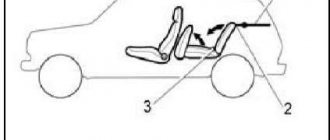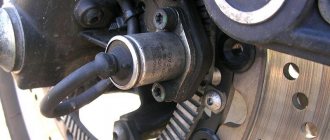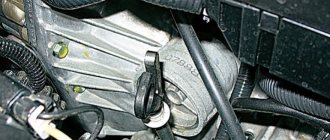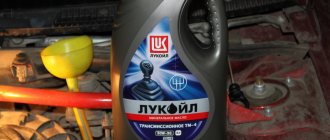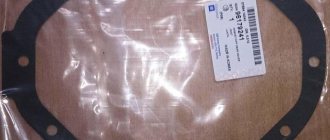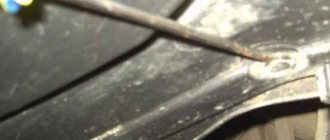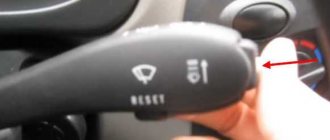Complete oil change for VAZ 21213 in all units
The service life of the vehicle directly depends on timely maintenance. Changing the oil is one of the operations that is performed in accordance with the regulations specified in the vehicle maintenance instructions. Changing the oil and consumables on a VAZ 21213 is easy to do yourself, following the step-by-step instructions. But this makes it possible to save time and money on visiting a service station.
According to the regulations, the oil on the VAZ 21213 must be changed every 10 thousand kilometers or every 2 years of operation. In addition, it is necessary to periodically check the condition of the lubricant. If the car is used in difficult conditions, the replacement period is halved to 5 thousand kilometers.
The frequency of replacement is influenced by the following factors:
- quality of fuels and lubricants;
- driver's driving style:
- terms of Use;
- technical condition of the vehicle.
It is recommended to fill in the same brand of oil that was filled previously. When changing the brand of lubricant or when purchasing a used car, you need to flush the engine system with a special flushing agent or new lubricant before replacing it. To flush, the old oil is drained and flushing or new lubricant is added. Next, start the engine and let it run for about 10 minutes. Next, drain the waste and begin the usual procedure for changing the oil.
The oil filter is changed along with the lubricant if it has run out of service life, which is the same as that of the oil - 10 thousand km. When replacing the lubricant ahead of schedule, the oil filter can be left, but experts recommend changing it at each replacement.
To carry out the procedure, you should prepare:
- new consumables: lubricant and filter;
- five-liter bottle for draining waste liquid;
- watering can;
- hexagon to “12” or wrench to “17”;
- screwdriver;
- oil filter puller;
- clean rags;
- gloves.
When buying motor oil, you need to pay attention to the viscosity. The manufacturer of VAZ 21213 recommends using a product with a viscosity of 5w-30 or 5w-40.
The replacement must be done on a warm engine. It is advisable to change the lubricant immediately after a trip. If the car has been parked, you will need to start the engine and let it run until it warms up to operating temperature. The heated lubricant drains better.
It is more convenient to carry out work on an overpass, inspection pit or other lifting device to provide access to the bottom of the machine. The car's wheels must be secured to prevent rolling back. To do this, use the handbrake. Additionally, you can place boards or shoes under the wheels.
The replacement process consists of a sequence of steps:
- Having unscrewed the mounting bolts, first remove the engine protection, if any.
- Next you need to unscrew the plug on the drain hole. Depending on its type, we do this with a hexagon or a “17” key.
- We place the prepared container under the drain hole in advance. You can use a five-liter plastic bottle.
- We wait until all the waste liquid is drained. This takes no more than 15 minutes. Be careful when draining as the oil is very hot and can cause burns. You should work with gloves.
- The next step is flushing the system, if necessary.
- After draining the lubricant and flushing the system, we proceed to replacing the oil filter. We place a container under the place where the filter is located, since residual lubricant may leak out of it.
- We unscrew the oil filter manually or using a special wrench.
If you cannot unscrew it manually and there is no puller, you can use a screwdriver or any long sharp tool. We pierce the filter housing and, using a screwdriver as a lever, unscrew it.
- Next, we clean the seat of the product from dirt so that it does not get into the engine with new lubricant.
- On a new product, be sure to apply fresh engine oil to the seal. We fill the new consumable halfway with lubricating fluid so that it gets into the system faster and the engine elements do not rotate without lubrication.
- Screw the prepared filter onto the fitting by hand ¾ of a turn until the O-ring comes into contact with the cylinder block gasket.
- Next, unscrew the plug from the oil filler neck.
- We control the volume of the poured substance using a probe. It is considered sufficient if the oil on the dipstick is between the minimum and maximum levels.
- After filling in about 4 liters of lubricant, start the engine and wait for the oil indicator on the dashboard to go out. The lubricant should fill the entire system. We turn off the engine and measure the oil level again. If there is not enough lubricant, add more.
Throughout the entire operation of the vehicle, it is necessary to constantly monitor the level and condition of the engine oil. Top up and change as needed.
Changing gearbox fluid
The gearbox is the most reliable part of the car; it rarely fails. To keep it in working condition, you need to fill it with high-quality liquid and change it according to the regulations. The transmission fluid on the VAZ 21213 is replaced after 60 thousand km, checking the level every 20 thousand km. It is considered normal if the liquid in the crankcase reaches the edge of the oil filler neck. If necessary, add liquid.
Replacement is carried out in a pit or other device that provides access to the bottom of the car. To implement it on a VAZ 21213, you need to have on hand:
- hexagon to “12”;
- key to "17";
- a canister or container for draining the waste substance;
- special syringe;
- clean rags;
- new transmission fluid.
Before starting the procedure, you should warm up the gearbox. To do this, it is enough to drive 10 kilometers.
The replacement process takes place in stages:
- Going under the car, use a hexagon to unscrew the plug from the drain hole.
- Drain all the liquid into the prepared container.
- When the lubricant has completely flowed out, clean the plug from dirt and screw it back into place.
- We unscrew the plug on the filler neck with a key to “17”.
- We use a syringe to fill in new oil.
- Pour in the liquid and control its level. Normal - grease reaches the lower edge of the neck.
- Screw the plug back.
This completes the replacement procedure.
Changing the lubricant in the rear axle
The oil in the unit is changed in the same way as in the gearbox, every 60 thousand km, and the level is checked after 20 thousand km. The required level is the edge of the hole through which the oil is poured.
For replacement, we are preparing a set of keys, a 5-liter container, and clean rags.
Replacement sequence:
- We set the car on a hill, having previously warmed up the bridge, driving 10 km.
- Taking a hexagon, unscrew the plug from the drain neck and let the oil flow into an empty container.
- Wipe the unscrewed plug with a clean rag and return it to its place.
- Using a key set to “17”, unscrew the plug on the hole through which we will fill the lubricant.
- Using a syringe, pour in the prepared oil until it is flush with the edge of the filler hole.
- Using a key set to “13”, unscrew the breather. Clean it and screw it back in.
Other liquids and fuels and lubricants
Every car enthusiast should know by heart the maximum fuel capacity of his car. The fuel tank of the VAZ 21213 has a capacity of 42 liters, including reserve. The reserve refers to the amount of fuel remaining in the tank after the yellow warning light on the instrument panel turns on. The reserve amount is at least 5 liters. The car must be fueled with gasoline whose octane number is in the range of 91-93.
The car has a number of refueling tanks that the owner must monitor during operation:
- brake system with expansion tank, total capacity - 0.515 l;
- hydraulic clutch drive with expansion tank - 0.2 l;
- 2 plastic tanks with a volume of 2 liters each contain a supply of windshield and rear window washer fluid.
The clutch release drive and brake system are filled with hydraulic brake fluid (the most popular is DOT-4). It should be changed at least every 3 years, because the liquid has the ability to absorb water vapor contained in the air. As a result, all steel parts of the system in contact with it begin to corrode, which leads to complete or partial failure of the brakes.
If there is a leak in the clutch or brake system, the level in the expansion tanks decreases, so constant monitoring is required over them.
The level of brake fluid in the reservoirs must be maintained no lower than the corresponding mark on the plastic body of the container.
Liquid or clean water for washing glass is added if necessary; in winter, a non-freezing option is required. Otherwise, the ice will not only destroy the tubes, but also damage the electric pump.
Various thick lubricants are also used for maintenance and lubrication of the Niva:
- Litol - a composition for lubricating highly loaded bearing parts;
- CV joints-4 - lubricant for the hinges of the front axle shafts and door opening limiters;
- ShRB-4 is designed for processing ball joints and steering rods.
The list of refueling containers is useful for novice car enthusiasts who bought a used car with a lost instruction manual. The operation of such a car should begin with the replacement of all fluids and oils.
How to change oil in VAZ Niva axles - AvtoMaslo
28.06.2019
» Articles » 21214 Niva oil change in transfer case
For any vehicle, the importance of timely replacement of lubricants cannot be overestimated. Oils used in components and assemblies subject to friction at high speeds significantly reduce their overheating and wear, helping to extend their service life.
Among such components, one cannot fail to note the transfer case, which is equipped with all-wheel drive vehicles.
Both old Niva cars and models under the Chevrolet brand, produced since 2002, need no introduction - these are one of the most popular all-wheel drive vehicles in our country, which have earned the love of motorists for their unpretentiousness, ease of maintenance and low cost.
What is especially pleasing is that the vast majority of maintenance operations on a domestic SUV can be performed independently, without turning to the help of specialists or a car service center. In particular, this also applies to changing the oil in the Niva transfer case - a procedure that does not require special professional skills or special tools.
The oil in the Niva transfer case should be checked every 10 thousand km.
Replacement frequency
According to the recommendations given in the service book, the oil in the transfer case of a Niva car should be changed for the first time during the fourth maintenance, that is, after driving 45 thousand kilometers. Then the procedure should be repeated with the same frequency.
It should be especially noted that on the new Niva the transmission oil is changed after running-in (2000 km). It is recommended to check the lubricant level in the transfer case every 10 thousand kilometers.
However, experts advise focusing not so much on the recommended indicators, but on the condition of this important unit, as well as factors related to the operating conditions of the vehicle.
It’s one thing when the car drives mainly on good roads (urban, on country roads), and quite another when its owner lives in the countryside or is an avid hunter, fisherman, or simply a big fan of outdoor activities.
In such cases, checking the level and quality of the oil in the transfer case should be carried out more often, and if signs of fluid contamination appear, it should be replaced without waiting for the regulatory deadlines.
So you decide for yourself when to change the oil in the Niva transfer case, taking into account all the above factors.
Checking the oil level
The procedure for checking the oil level in the Niva transfer case is quite simple, in any case, it does not require any special skills.
The only difficult point is that it is necessary to provide access to the bottom of the car, for which you will need to drive it into a hole, overpass, or securely install it on blocks.
The second point is that the check must be carried out on a cold car, so if you have driven somewhere before, wait until the car has cooled down.
The procedure itself is simple - just unscrew the filler plug with a 12mm hexagon, having first thoroughly cleaned the seat of dirt, and use a suitable object (a wooden stick or a piece of wire) to measure how much lower the liquid level is at the bottom edge of the hole. If this distance exceeds 10 mm, topping up should be done, which is done using a special syringe. You need to add until the lubricant begins to flow out of the hole, then wipe the box dry and tighten the plug.
Choosing the right oil
The issue of choosing a lubricant for the Niva transfer case and axles should be taken responsibly, because the reliable operation of these transmission elements ensures that you will never find yourself in a situation requiring outside help.
Recommended transmission fluids have characteristics that ensure optimal operation of the vehicle component for which they are intended. If you know exactly what kind of oil is poured into the transfer case, the choice is simplified: just purchase a lubricant with the same viscosity.
If this information is not available, it’s also not a problem: you just need to drain all the old transmission fluid, that is, do not limit yourself to topping up if, say, the level is too low and the lubricant itself is not yet very contaminated.
The automaker fills the transfer case with mineral water, but when replacing the fluid, the preferred lubricant would be semi-synthetic, which has better performance characteristics that are more suitable for the climate of our country.
How much to fill
According to the data given in the operating manual, the volume of oil poured into the transfer case of the Niva-2121 and more modern modifications (21213, 21214, 21310) is 0.75 liters. Some reference books give a figure of 0.79 liters, which is not important - you still need to purchase liquid packaged in a 1-liter container.
The procedure for changing the oil in a Niva transfer case yourself
If, as a result of another check of the level or quality of the transmission fluid in the transfer case, it turns out that it is time to replace it (symptoms indicating the need to perform such a procedure may be not only a very dark color of the oil with the inclusion of solid particles, but also the appearance of noise when turning on the transfer case or during its operation), you can perform such a replacement on your own.
To do this, you will need a 19 and 12 hex wrench, a liter container for used lubricant and some rags. It will also be necessary to provide access to the car from the bottom, for which you can use a lift, an overpass or an inspection hole.
Immediately before replacement, you should warm up the car (drive it for about 10 kilometers). Procedure for changing the oil in the Niva transfer case:
- We place a prepared container under the drain hole (preferably with a wide neck to avoid spilling liquid);
- Using a 19mm hex key, unscrew the drain plug, being careful not to get dirty or burn yourself;
- thoroughly clean the plug itself and the magnets installed on it from all dirt and metal shavings;
- when the transmission fluid stops dripping, install the plug in its original place, ensuring sufficient, but not excessive tightening force;
- Using a 12mm hex, unscrew the filler plug, using a special technical syringe or funnel with a suitable neck, fill in fresh lubricant until its level reaches the lower edge of the technological hole;
- tighten the plug;
- carefully clean the seat of the filler neck with a rag to remove any oil leaks;
- We repeat the same procedure with respect to the breather located at the transfer case on the side of the propeller shaft (rear).
Weaknesses of Niva Chevrolet 2002-2009 release
- Valve train chain;
- Throttle sensor;
- Cooling system;
- Transfer case;
- LCP;
- Problems in manual transmission.
In general, the gas distribution mechanism on this car is very unreliable and requires special attention in maintenance and constant monitoring during the entire operating cycle of the car. The fact is that if the elements of the gas distribution mechanism are untimely replaced or installed incorrectly, the chain may jump a couple of teeth, which will lead to sad consequences, namely the failure of the heart of the car - the engine. Therefore, when purchasing, you need to pay attention to the operation of the units under the hood. When the timing chain is not tensioned, a significant operating noise is heard. And as a result, in the near future you may encounter problems such as breakage of the damper or limiting finger.
One of the common problems with the Chevrolet Niva is also the failure of the throttle sensor. This malfunction is not critical and its repair is not expensive, but it is important to know that this does not happen as rarely as we would like. A sign of this malfunction is the random stopping of the engine during planting after a long period of parking. Therefore, although the sensor is not expensive, it will be necessary to replace it. This is important to know both for the future owner of this car and for the present one who has not yet encountered this problem. The sensor may also fail when the car's mileage is less than 10 thousand km. after the last sensor replacement.
Here it is necessary to highlight two important and at the same time most problematic elements of the system - the radiator itself and the expansion tank. Very often, owners of this Chevrolet model complain about radiator leaks. And indeed, this malfunction mainly arises due to a design flaw in the radiators themselves. But it is also important to note that the so-called expansion tank is no less a significant headache for Chevrolet Niva owners. Even in slight cold weather, the tank can burst at the seams and the worst thing is if this happens on the road. Therefore, this problem must be taken seriously and conclusions drawn.
The most common problem with these boxes is knocking out fifth and reverse gears. There is only one reason - the gear selector mechanism is not adjusted. The input shaft bearing may “die” around 50-60 thousand km. You can check this yourself first. When the clutch is depressed, the noise in the gearbox disappears, so the bearing most likely needs to be replaced. Another problem with this unit is a leak in the area of the speedometer drive.
The weak point in the transfer case is the oil seals. It is not uncommon for many Chevrolet Niva owners to notice oil leaks and the transfer case itself being covered in oil. You can check this yourself by visiting the pit. But it is important to know that oil can also be squeezed out through the O-ring of the gear shift rod. This problem occurs when the breather is clogged. Therefore, in any case, for example, when purchasing this car, it is necessary to check the transfer case, at least visually and during mileage.
The paintwork on this car is not of very high quality, namely weak anti-corrosion protection. Even owners of new Chevrolet Nivas noticed traces of corrosion in the third or fourth year of operation. It is especially necessary to pay attention to the paintwork of the wheel arches.
Less frequent malfunctions of Niva Chevrolet:
- Failure of the oil pump (around 100 thousand km);
- Idle speed regulator (in the same mileage area);
- Burnout of the cylinder head gasket;
- Failure of the starter (90-100 thousand kilometers);
- Tearing off the lower radiator pipe;
- Destruction of the exhaust manifold mounting;
- Handbrake cable;
- Pump leaking;
The main disadvantages of the Chevrolet Niva:
- Vibration of the manual transmission lever;
- Poor sound insulation;
- Separate heating of feet and windshield;
- Small trunk volume;
- Low quality of spare parts;
- creaking trunk door;
- “crickets” in the plastic of the panel;
Conclusion.
From all of the above, we can conclude that in general the Chevrolet Niva car is intended for those who like to constantly repair their car. And what is most important is that any part or assembly as a whole on this car can fail at any time.
Changing the oil in the VAZ 2121 gearbox
How often do you change the gearbox oil? — According to the car’s service book, the gearbox oil needs to be changed every 40 thousand km. If the car is new, then the first replacement must be made after 2 thousand km, and the next replacement after 40 thousand km.
How much oil should be poured into the gearbox? — 1.6 l.
What kind of oil should I put in the gearbox? — Gear oil with API GL-5 and viscosity 75W-90 Use the table to determine the oil of the appropriate viscosity. See recommended oil brands here .
Recommended temperature ranges for use of transmission oils.
Is it necessary to flush the gearbox when changing the oil? — If the oil is excessively contaminated or has foreign impurities, the gearbox can be washed by pouring 1 liter into it. flushing oil. — Close the filler plug, set the transfer case lever to the neutral position, engage 1st gear in the gearbox and run the engine for 2-3 minutes; — drain the flushing oil completely;
— wipe the oil drain plug and put it in place.
https://www.youtube.com/watch?v=EykBwTvzr6A
We carry out the work on an inspection ditch or a lift. Before changing the oil, you need to warm it up by driving the car for at least 10 km. and immediately begin replacing before it cools down.
Use a 12mm hex to unscrew the drain plug...
...and drain the oil into a substitute container. (prepare a container with a volume of at least 2 liters)
Cleaning the drain plug magnet...
Using a 17 key, unscrew the filler plug. We perform flushing (if necessary) as described at the beginning.
Using a syringe, fill in new oil to the level of the lower edge of the filler hole (in the photo the front driveshaft has been removed for clarity).
The oil level should reach the edge of the filler hole, or millimeters below.
We wrap the filler plug.
Owners of domestic VAZ 2121 and 2131 cars should know what gear oil to fill and how to do it correctly with their own hands in a garage? This requires a suitable lubricant and a certain set of tools, and we will talk about this in detail in today's material.
The physical and mechanical properties of various Niva gearbox oils affect their performance properties. Not every car owner understands the intricacies, and determines the oil only by the range of use of a particular product. Experts recommend following a number of criteria when choosing gear oil for Niva:
- the oil must be suitable taking into account the current condition of the gearbox;
- the product must meet the requirements of the car manufacturer;
- suitable for the season of operation of the car;
- gear oil for VAZ 21214 or 21213 must be real.
Another important rule should be mentioned: never choose oil based on the principle that the more expensive the better. Often it turns out to be completely wrong.
Manufacturer's requirements
The car manufacturer, taking into account the design features of a particular transmission, puts forward requirements that the oil used by car owners must satisfy. These requirements are always indicated in the service book. On the packaging of any oil, in addition to the product name, there is always a marking with the following information:
- viscosity grade;
- operational group.
The gearboxes of VAZ 2121 all-wheel drive vehicles have a hypoid main pair, which operates at high speeds at low torques and shock loads on the gears. Oils for these domestic machines must belong to the following operational groups:
- according to foreign API classification: GL-5;
- according to national standards - 5th group.
After studying the service book for the car, you will find the automaker's recommendations for a specific group. Using lower groups of oils in hypoid axles will lead to unpleasant consequences. For example, scuffs may form on the rubbing elements, and this will cause expensive major repairs or replacement of the entire gearbox. First of all, this is due to the fact that oils of low performance groups have lower welding load and scuffing index, that is, they cannot withstand the necessary loads.
Another important indicator that is present in the marking of gear oils is the viscosity class. All oils, including transmission oils, are divided into all-season and seasonal.
Read about changing engine oil in Niva on our website at the following link.
Seasonal oils
They are classified as Newtonian fluids, in which the viscosity depends on the operating temperature. When it increases, the viscosity decreases in direct proportion, and when it decreases, the viscosity increases. Seasonal oils are not subject to temporary drops in viscosity due to the absence of expensive thickening fillers in order to reduce the cost of the product.
Source: https://AVSU-pitanie.ru/info/zamena-masla-v-kpp-vaz-2121/
Why and when do you need to change the oil?
The Niva's gearbox needs to be regularly refilled with new oil as part of scheduled maintenance, since transmission fluid is prone to wear and requires replacement from time to time.
The gearbox in a car is responsible for changing the engine torque and adjusting the transmission of motion to the drive axles. A serviceable gearbox effectively regulates traction and speed characteristics over a significant range, allowing the engine to operate as productively as possible. Changing the oil in the Niva 21214 gearbox is a simple procedure, but you must follow a number of rules. If everything is done correctly, the unit will last for many years and there will be no serious problems with it. Only one fluid is used for axles and transfer case; be sure to take into account the manufacturer’s recommendations when choosing.
Fresh, high-quality oil is yellow in color, free of foreign impurities and a sharp burnt odor.
The Niva 21213 gearbox needs to be refilled with new oil on average every 50 thousand km, but this is a conditional interval, the exact interval depends on a number of factors. In the boxes of machines operating in difficult conditions, destructive processes can begin, and the fluid will eventually fail much earlier than it could. To understand whether it is time to pour new gear oil into the Niva gearbox or not, checks are done. You need to pay attention to color, smell, and the presence of foreign inclusions. If the transmission fluid has changed its characteristics significantly, we can talk about its significant wear.
The Lada 4x4 transmission oil will last longer if you follow these simple recommendations:
- Reduce the speed of movement to approximately 100 km/h, make acceleration smooth.
- When using a manual, squeeze the clutch very smoothly, and when using an automatic, carefully shift the selector.
- Regularly inspect surfaces for leaks and oil smudges. If they are detected, a comprehensive diagnosis of the system is carried out at a service station.
- Add oil to the Niva box in a timely manner if its level is less than required.
Taking into account the described recommendations will increase the service life of the fluid and box several times. The replacement procedure is carried out at a service station or on your own - depending on the skill and experience of the driver. Most vehicle owners do the work themselves to save money.
Changing the oil in the Niva 21214 gearbox
For any vehicle, the importance of timely replacement of lubricants cannot be overestimated. Oils used in components and assemblies subject to friction at high speeds significantly reduce their overheating and wear, helping to extend their service life. Among such components, one cannot fail to note the transfer case, which is equipped with all-wheel drive vehicles.
What does the manufacturer recommend?
When changing the oil in a VAZ 21214 gearbox, special attention should be paid to the recommendations of the automaker. The company recommends filling the Niva transmission with the following lubricants:
- "NOVOIL T" (80W-90; GL-5);
- "OMSCOIL SUPER T" (85W-90; GL-5);
- "REXOL T HYPOID" (80W-90, 85W-90; GL-5);
- "VELS TRANS" (85W-90; GL-5);
- "VELSTM" (80W-90, 85W-90; GL-5);
- "UFALYUB UNITRANS" (85W-90; GL-5);
- "NORSI" (80W-90, 85W-90; GL-5);
- “LUKOIL TM-5 or VOLNEZT-1” (85W-90; GL-5);
- "LUKOIL TM-5" (80W-90.85W-90; GL-5);
- "ANGROL T" (80W-90, 85W-90; GL-5);
- "SPECTROL FORWARD" (80W-90; GL-5);
- "SPECTROL CRUISE" (85W-90; GL-5);
- "SAMOIL 4402" (85W-90; type GL-5);
- "SAMOIL 4404" (85W-90; GL-5);
- "SAMOIL 4405" (85W-90; GL-5);
- "AGIP ROTRA MP" (80W-90; GL-5);
- "AGIP ROTRA MP DB" (85W-90; GL-5);
- "MP GEAR LUBE-LS"
